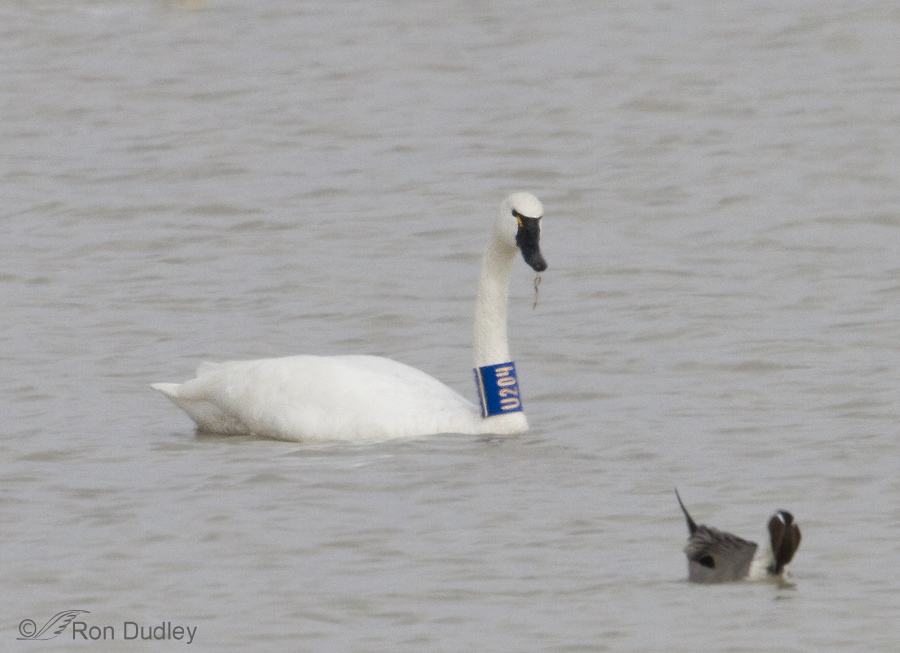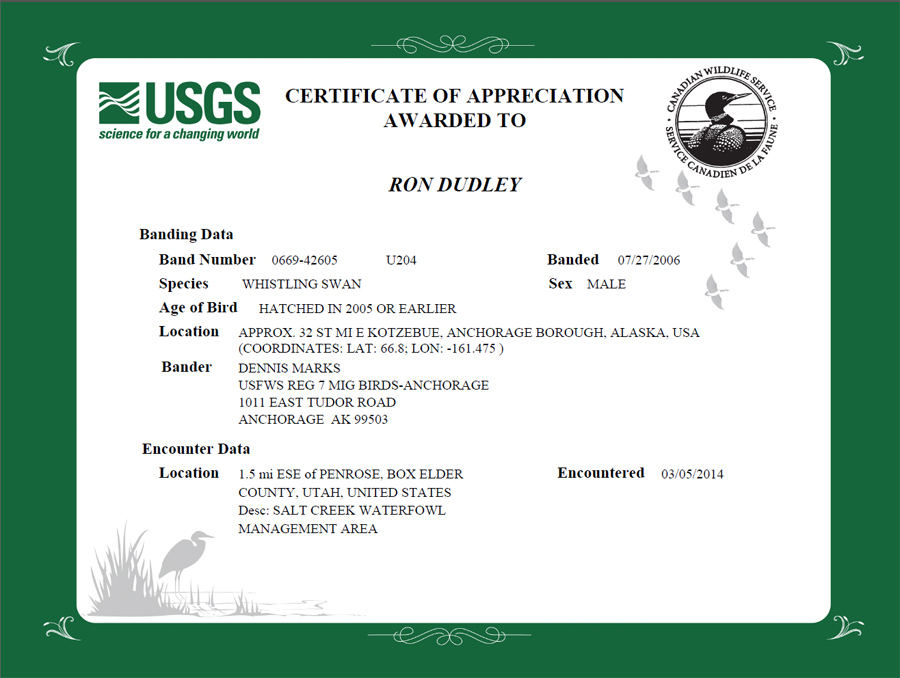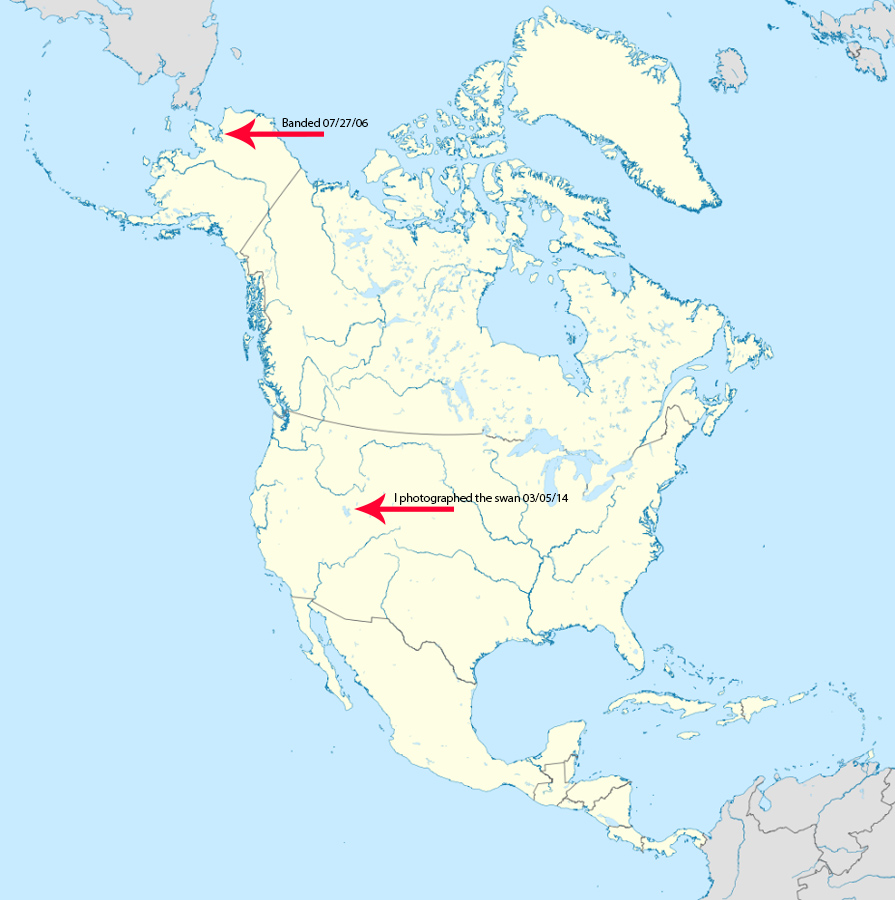Two weeks ago I reported a banded Tundra Swan I photographed at Salt Creek WMA. It wasn’t long before I received some interesting information back about that bird from the North American Bird Banding Program.
This is the swan I reported. The reporting process was quick and easy, including sending them this photo. The image is of poor quality but the neck-band can easily be read (U204) and that’s all that was needed. Twelve days later I received the following email from the banding lab (it isn’t a short read but it does a good job of explaining the need for banding programs).
“The North American Bird Banding Program
Bird banding is important for studying the movement, survival and behavior of birds. About 60 million birds representing hundreds of species have been banded in North America since 1904. About 4 million bands have been recovered and reported.
Data from banded birds are used in monitoring populations, setting hunting regulations, restoring endangered species, studying effects of environmental contaminants, and addressing such issues as Avian Influenza, bird hazards at airports, and crop depredations. Results from banding studies support national and international bird conservation programs such as Partners in Flight, the North American Waterfowl Management Plan, and Wetlands for the Americas.
The North American Bird Banding Program is under the general direction of the U.S. Geological Survey and the Canadian Wildlife Service. Cooperators include the U.S. Fish and Wildlife Service, Mexico’s National commission for the Knowledge and Use of Biodiversity and Secretary of the Environment and Natural Resources; other federal, state and provincial conservation agencies; universities; amateur ornithologists; bird observatories; nature centers; nongovernmental organizations such as Ducks Unlimited and the National Audubon Society; environmental consulting firms and other private sector businesses. However, the most important partner in this cooperative venture is you, the person who voluntarily reported a recovered band. Thank you for your help.
U.S.
Geological Survey
Canadian Wildlife Service
Please Report Bands at
www.reportband.gov
or
call
1-800-327-BAND”
Attached to the email was this Certificate of Appreciation that provided information about the swan that I found fascinating – including the date and exact location of banding, sex of the bird and the name of the bander (for some reason they’re still using the old name for the species – “Whistling Swan”).
Creative Commons image, I have added the red arrows and text
So “my” male swan is almost 9 years old (possibly even older) and was banded in 2006 by Dennis Marks in a remote area of Alaska (I looked up the coordinates for this map). It was banded approximately 2700 air miles from where I photographed the bird and it has made that one-way trip at least 17 times in its lifetime (since it’s likely this bird winters in California, each one-way trip would have been significantly longer than 2700 miles). Pretty impressive.
As a nature photographer who specializes in birds I’m not a fan of finding artificial “jewelry” on my subjects but I enthusiastically support any effort that potentially supports healthy populations of birds – including the efforts of the North American Bird Banding Program. I encourage others to report banding information (either leg or neck bands) to the banding lab (link and phone number provided above). Only about 7% of banded birds are ever reported or recovered – imagine how valuable it would be if that record could be significantly improved.
These days, birds need all the help they can get.
Ron





Ron, Because of your blog I received a Certificate of Appreciation today from the U.S. Geological Survey for the bird band program!!! Last Sunday I photographed an American White Pelican at the Sepulveda Wildlife Basin in Los Angeles County 4/6/2014. There were about a dozen white pelicans that were lounging together and then started to fly around the little lake. I took a few shots, and didn’t know what I had until I got home and looked at them. I saw a dark marker with light numbers 5E6 under it right wing. I deliberately overexposed the photo to be able to read the marker. On Tuesday I tried to report it to ReportBand.gov. The site said it was an invalid number. I called the office and didn’t get good info but was referred to Customer Service, so I persisted and called that office. I rec’d a call this morning from a very nice man who said he would research the info. He said many people are “tricked up” on their site because of one of the box choices they select at the beginning of the report. Because I only had 3 numbers, I should have selected “colored marker.” Because the marker was B&W, I selected the box that had the word “camera” in it. The man found the info in less than a day. The certificate says the pelican was banded last year (July 2013) in Boise, Idaho, before it could fly. So evidently, it is on its first holiday here in sunny Southern California (827 mile flight). He added that any bird banding group, whether government, amateur, or other, must go through their dep’t first for permission.
Neat, Susan! Thanks for letting us know about your experience. I too had a little trouble interpreting their form when I was filling it out.
Very interesting Ron. One of my friends had a similar experience. We were together in Horicon Marsh and he had the best photo of a bird ( I have forgotten the type) with a big wing band. He reported it and was given detailed information. It is so interesting to learn this information.
Wow, I find this fascinating. A friend reported a band on a peregrine falcon a little way out of the city and it turned out to be one of the falcons that was hatched from the top of one of the buildings downtown and the wildlife folks were very happy to get the news that one of the fledglings survived.Thanks for sharing some of this swan’s journey.
Interesting, thanks for sharing. As a wildlife biologist who has banded my share of birds, I do concur it is important to report, it’s valuable info. I do not, however, agree with their continued use of these neck bands, which have been known to cause injury and mortality, something biologists don’t like to talk about…but should. I have seen regular leg bands cause their share of problems, so that is also something to report when seen even if you can’t identify the number (such as a government-issue metal band with tiny numbers) or if it is just a color band. Report the color, and which leg it is on always. Look for things likes leg or foot swelling, fibers or such stuck in the band, and report those as well.
That’s very interesting, Renee. I guess I just assumed they wouldn’t be using neck bands if they weren’t reliably safe. Disappointed to learn that’s not the case.
What a coincidence. I reported a banded Ring-billed gull 2 days ago.
I never would have noticed the band in the wild, but it showed up clear with a 500mm zoom lens.
Yes, it’s amazing how much easier it is to read a band through a long lens. Thanks, Bruce.
Some time ago Bryce and I wondered if an increase in nature photography might lead to a higher percentage of band reports. The answer would unquestionably be yes if all us photographers matched your talent and time in the field!
Ps- Re. Tana’s comment about the kestrel project: the family of kestrels she helped me band last June in Holladay migrated en mass in early November. Nary a kestrel was seen there for months, until a male showed up at the nest box two weeks ago. Wearing a band! As of today he was still waiting on his mate who happened to be a late returner last year as well. It sparks my imagination wondering where he wintered- a few or a few thousand miles south- but I hope to not find out for years to come.
What an interesting story, Mike. I hope the female shows up soon and that you don’t “find out” for a very long time.
Thanks for this fascinating and thorough information. I had no idea that any organization would want a photo with the number of a banded bird. I had no idea the banded birds were tracked so extensively. I will save your info in case I or someone else I know comes across a situation where the band number can be seen. Great info!
Great! That’s exactly what I was hoping for, Susan – that some folks who weren’t aware of these efforts would begin reporting band numbers if/when they see them. Thank you.
I will also help to spread the word to other photographers to be on the look out and let their friends know. Do you know if anyone is interested in photos of banded birds if you can’t recognize the number? i,e, if the color of the band might be of any interest?
Susan, I doubt it would be helpful if the numbers can’t be read at all. However, I saw a report here http://www.naturephotographers.net/imagecritique/bbs.cgi?a=vm&mr=76656&CGISESSID=1282ae1b2d0c3387a222590c5d572cff&u=11182 where it is stated that they can attribute the band even if the number can’t be completely read.
EXCELLENT!! As a bird bander for 40 years, this kind of information is great news to the Banding Office, the individual who is studying these swans and to you Ron,the one turning in this information. Just imagine what these birds go through to survive for as long as they do. I had a Common Tern I had banded and its band number returned who had lived for 16 years. That is traveling from Cape Cod Massachusetts to Brazil and back again for 16 years. Without bands and people turning these band numbers into the banding office we humans would have a lot less knowledge of their behavior, ages, migration paths, etc I used banding as an educational tool in my high school teaching, and have very fond memories of those times in the field with students.
Very well said, Dick. And I know what you mean about those kinds of memories with your students.
How fascinating. And what a distance that survivor had travelled. I hope he flies for many, many more.
I hope so too, Elephant’s Child.
what fabulous information, Ron!! Thank you!!!
I’m glad you appreciated the info, Lois. Thanks.
Fascinating! Such a long journey!
Many times a “long journey”, Leisa. These birds are amazing.
Thank you for spreading the word about banding. I have been fortunate enough to help with banding kestrels, and the hope and purpose are that some day we will learn more about their habits, and why they seem to be declining. I agree that the wild life in our world needs all the help it can get considering all the roadblocks, pitfalls and obstructions that humans put in the way of their survival.
Tana, I’m familiar with some of your work with our local kestrels and appreciate your efforts. Kestrels in particular need a lot of help these days. I only saw two of them the entire time I was in Wayne County last week.
Hi, Ron! I did this very thing with a Canada Goose about a month ago that I found along the Jordan River and received the same type of certificate. I showed it off to everyone in my family and was able to have a great discussion with my kids about how this information helps out the bird population and the future of that species. What a cool way to get my kids involved!
Steve, I love the way you handled the goose situation with your kids. Good for you!
Great shot and info Ron!
Charlotte
Thanks, Charlotte.
Very Interesting info indeed. Good to know the link/phone number to report, if I encounter a banded bird. Thanks!
Good! I hope other folks follow your lead, Bill.
Great info Ron. I never knew bands were put around the necks of any birds. That surprised me. The information gathered from that swan’s band was so interesting. Nice job as always.
Ellen, neck bands are commonly used on larger waterfowl like geese and swans.
Another piece of interesting information – thank you.
Thanks, Patricia.
Nice find Ron, very interesting. It is so neat to learn about the life of the migratory birds from data like this.
Yes it is, Ed – very satisfying. Thank you.
Great information Ron!
Thanks, Steve. I’m glad it was helpful.